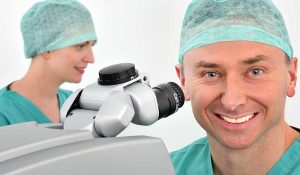Success rates for Cataract surgery are very high compared to other types of surgery, in fact, more than 99 per cent of people have successful cataract surgery. Most people choose to undergo cataract surgery when their vision is compromised by clouding in the lens of the eye. This is a common feature of ageing and is only corrected by surgery. Cataract surgery is basically the removal of the eyes natural lens (using a tiny ultrasound probe to gently breakdown the damaged lens) and replacement with an artificial lens. This procedure of lens exchange can restore vision completely. We’re lucky to care for patients who often find their transformation life changing.
A common misconception with cataract surgery is that a cataract has to be mature to be treated. This is far from the case as treating cataracts early can actually lead to a more straightforward operation with less risks and a higher chance of success with post surgery vision. We always recommend patients be treated without delay by one of our experts.
If you think you may be suffering from cataracts, make an appointment with your local optometrist.
‘Changes in vision could be nothing to worry about or they could be a sign of a more serious change in the eye’s inner workings. This is why we always encourage patients to make an appointment for a review if they notice any changes. We can identify cataracts very easily from a check up and can help provide an onward referral to an ophthalmologist if needed.’ Optometrist, Ian Jarvis.
The benefits of faster treatment
Within the NHS, cataract surgery is normally carried out once the cataract has reached maturity. Many people therefore make a logical assumption that this is when it is best to treat cataracts. However, the reason the NHS usually wait until cataracts are mature is more to ensure they are able to manage the cost of providing surgery as best they can. Budgets are not unlimited and therefore a system of prioritising by clinical need inevitably has to take place. The advantage of private surgery is that you are funding your treatment through private health insurance or paying yourself, so you can have treatment at a time that will allow you to achieve optimal vision. This is when a cataract is first detected. There’s no need to wait.
Types of cataracts
Your vision is affected by one of two types of cataracts: nuclear sclerosis and cortical cataracts. Nuclear sclerosis turns the lens yellow and your colour vision changes and you’ll also need to change glasses as you become more short-sighted. Cortical cataracts involve the development of white streaks just under the surface of the lens. When they extend from the periphery to the centre, they interfere with vision which gives rise to glare and dazzle, especially at night time when driving. Surgery is the only option to remove them, with a replacement lens being implanted. The process has been refined over seven decades and at Laser Vision Scotland, our surgeons carry out more than 2,000 eye operations every year.
Which surgery should I go for?
You have three options:
-Standard cataract surgery
-Multifocal cataract surgery
-Toric cataract surgery
Standard surgery involves cataract removal and replacement with a monofocal lens. Standard surgery will remove your cataract but will not improve any pre-existing vision problems such a short or long sight. You will still need to wear glasses or contact lenses to correct vision.
As the surgery would suggest, Multifocal (now known as trifocal) Cataract Surgery can help you reduce your reliance on glasses. In suitable patients trifocal lenses have a high success rate and high levels of patient satisfaction after cataract surgery.
So if you already used contact lenses or glasses before your cataract developed, cataracts surgery can restore your pre-cataract vision and remove the need to wear glasses completely. It’s also worth noting that once your cataract is removed it will never grow back.
Finally, Toric Cataract Surgery can also remove the need for glasses. This surgery uses lenses that are capable of correcting mild to severe astigmatism which can also cause blurred vision. Toric surgery can be a perfect option for those who are happy to wear glasses for reading.
Your surgeon may even recommend a mixture! Toric mono vision treatment is when your dominant eye is made as strong as possible for distance and your non-dominant eye is better for near vision. It sounds like a strange idea but once the brain adapts to this style of vision, many people find they adapt to it very well.
We understand that deciding when to have cataracts removed is influenced by a number of factors.
Your sight may already be affected and you want to address it as quickly as possible. Or you might have other conditions that mean you would prefer to take your time. Maybe you only have vision in one eye or your needs are changing day to day. We can help talk you through all the considerations before surgery.
To find out which surgery is best for you, book an appointment with one of our consultants today.
Read our blog ‘All you need to know about cataract surgery’


